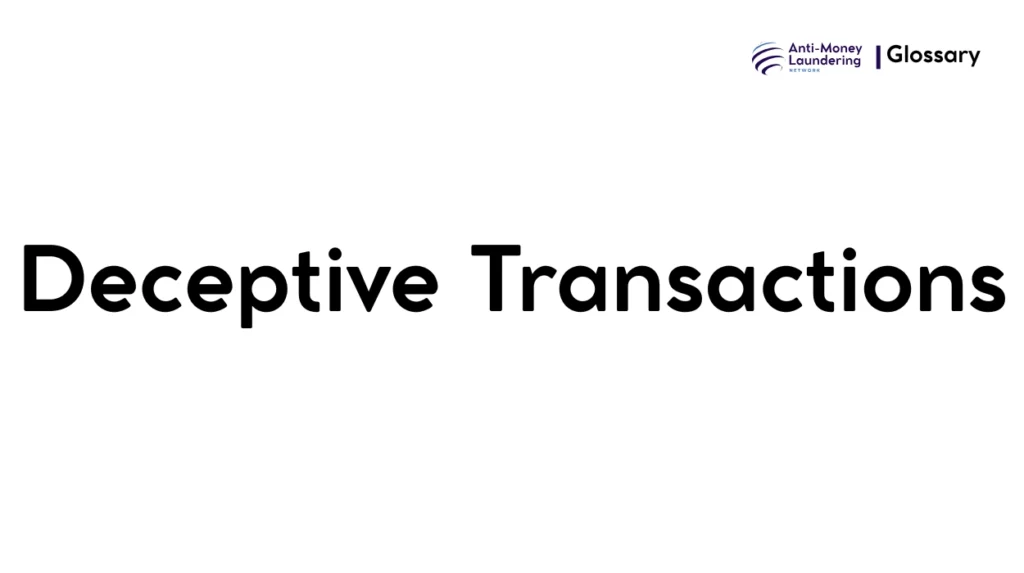Definition
Deceptive transactions in AML refer to financial activities deliberately structured to mislead or obscure the true nature, origin, or destination of funds. These transactions aim to evade detection, bypass regulatory controls, or disguise illicit proceeds as legitimate money. They are a critical method by which criminals launder money through complex or disguised financial maneuvers.
Purpose and Regulatory Basis
Deceptive transactions are a primary concern in AML efforts because they conceal the proceeds of crime, enabling criminals to integrate illicit money into the legal financial system undetected. AML regulations globally, such as the Financial Action Task Force (FATF) Recommendations, the USA PATRIOT Act, and the European Union’s Anti-Money Laundering Directives (AMLD), emphasize identifying and preventing such transactions to disrupt money laundering and terrorist financing networks. Regulatory frameworks require financial institutions to establish controls to detect, prevent, and report deceptive transaction patterns.
When and How it Applies
Deceptive transactions arise when criminals engage in financial activities that look legitimate but are constructed to hide illegal funds. Examples include using layered transactions across multiple accounts or jurisdictions, disguising the origin of funds through false invoicing, or involving third parties to obscure ownership. Trigger points include unusually complex transfers, inconsistent transaction patterns relative to customer profiles, or transactions designed to avoid reporting thresholds. Real-world cases involve shell companies used to mask true ownership or virtual currency exchanges to anonymize transfers.
Types or Variants
Deceptive transactions manifest in several forms, including:
- Structuring/Smurfing: Breaking large sums into smaller deposits below reporting limits.
- Layering: Moving funds through multiple accounts, often in different countries, to disguise origin.
- Round-Tripping: Moving funds through circular transactions that return to the origin, creating false legitimacy.
- Trade-Based Money Laundering: Using deceptive or falsified trade documents to justify fund transfers.
- Use of Third Parties: Involving intermediaries or straw men to conceal beneficial ownership.
Procedures and Implementation
Financial institutions must implement robust AML programs to detect deceptive transactions, including:
- Customer Due Diligence (CDD) and Enhanced Due Diligence (EDD) to understand customer backgrounds.
- Transaction monitoring systems that flag unusual patterns or behaviors inconsistent with customer profiles.
- Setting clear thresholds and rules for suspicious activity detection, including automated alerts.
- Training staff to recognize and escalate suspicious activities.
- Periodic audits and independent reviews of AML controls to ensure effectiveness.
Impact on Customers/Clients
From a customer’s perspective, AML compliance involving deceptive transactions may result in:
- Heightened scrutiny, including requests for additional information or documentation.
- Temporary restrictions or holds on accounts during investigations.
- Possible denial of services if suspicious behavior is confirmed.
- Rights to appeal or clarify suspicious findings, subject to local legal frameworks.
Duration, Review, and Resolution
Once flagged, suspicious deceptive transactions lead to ongoing reviews typically aligned with AML risk management cycles. Institutions often retain records and monitor accounts for extended periods (e.g., five to seven years) per regulatory requirements. Reviews involve updating risk assessments, investigating the transaction’s context, and potentially filing Suspicious Activity Reports (SARs). Resolution depends on regulatory feedback and internal compliance outcomes.
Reporting and Compliance Duties
Institutions are obligated to report suspicious deceptive transactions promptly to the relevant Financial Intelligence Units (FIUs) or regulatory bodies. Documentation must be comprehensive, including detailed transaction analyses and customer information. Failure to comply may result in heavy penalties, reputational damage, and regulatory sanctions.
Related AML Terms
Deceptive transactions relate closely to concepts such as:
- Suspicious Transaction Reporting (STR)
- Beneficial Ownership
- Structuring
- Layering
- Trade-Based Money Laundering
- KYC (Know Your Customer)
Challenges and Best Practices
Common challenges include detecting subtle or complex transaction patterns that mimic legitimate business activity and managing high false positive rates. Best practices involve:
- Leveraging advanced analytics and AI-based monitoring tools.
- Integrating cross-jurisdictional data.
- Continuous staff training.
- Collaborating with regulators and industry peers to update typologies.
Recent Developments
With the rise of digital currencies, decentralized finance (DeFi), and faster cross-border payments, deceptive transactions have evolved, incorporating new technologies to obfuscate sources and destinations of funds. Regulators are responding with enhanced guidelines on virtual asset service providers and increased focus on transaction traceability technologies.
Deceptive transactions constitute a core AML threat that undermines financial integrity by masking illicit funds. Effective detection, monitoring, and reporting of these transactions are essential responsibilities for financial institutions under global AML regulations. Staying vigilant against evolving tactics and implementing robust controls strengthens the fight against money laundering.

